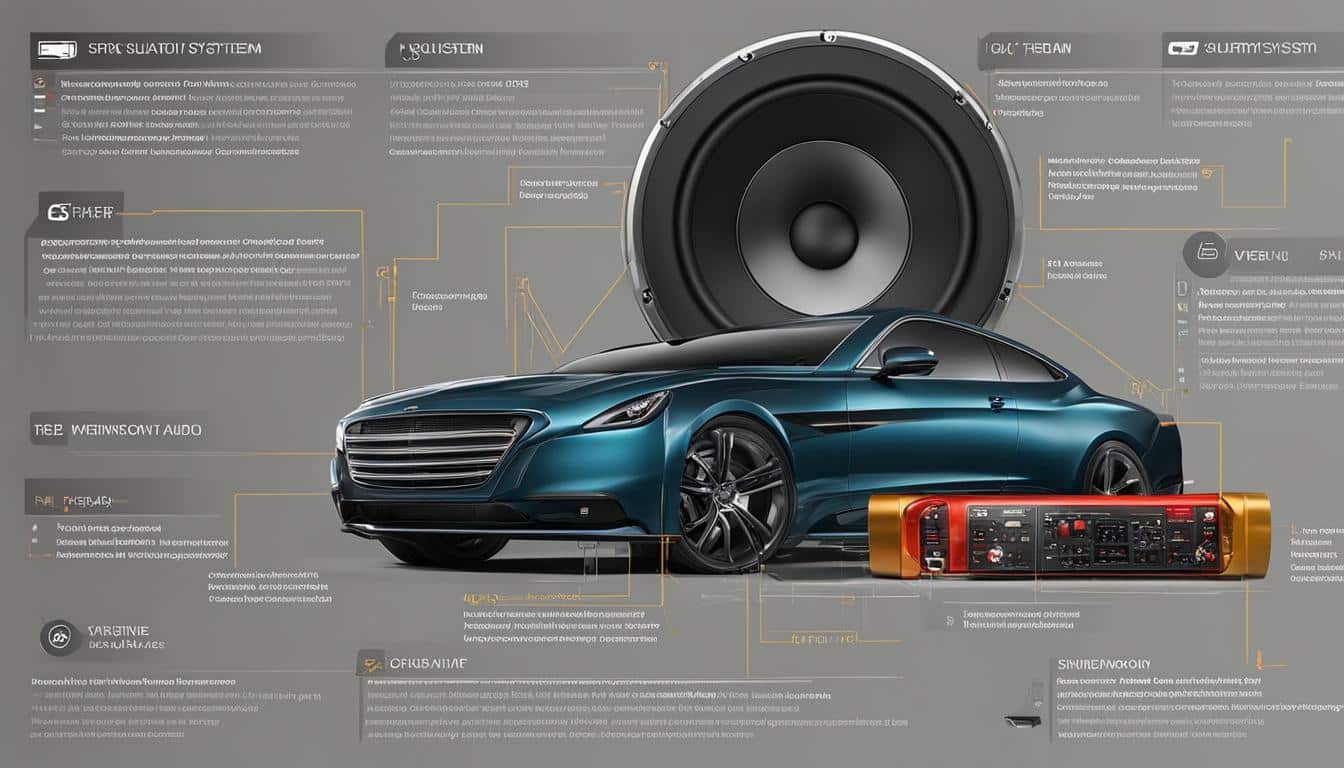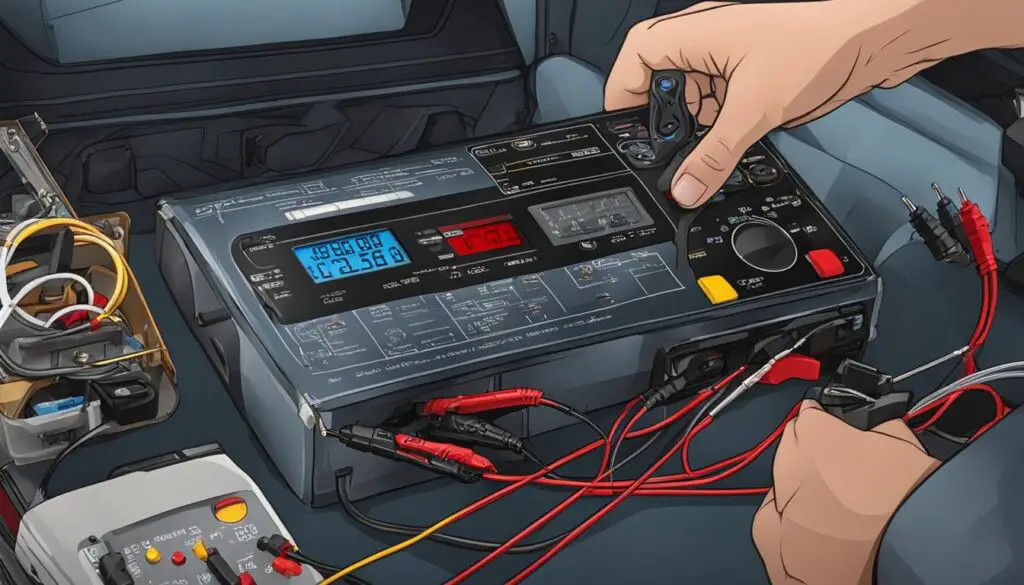
Essentials of Car Audio Troubleshooting
As a car owner, you might have faced issues with your car audio system at some point in time. Whether you hear weird noises, have connectivity problems, or experience sound quality issues, it can be frustrating to troubleshoot car audio problems without knowing where to start.
In this section, I will guide you through the essential techniques and solutions for troubleshooting car audio issues. From diagnosing common problems to utilizing advanced troubleshooting techniques, you will gain the knowledge and tools necessary to restore your car’s audio system.
First, it’s essential to understand common car audio issues that you might encounter. Problems with sound quality, connectivity, and functionality are the most common. You might hear crackling or popping sounds, experience poor sound quality, encounter issues with Bluetooth or auxiliary connectivity, or face a complete audio system failure.
Fortunately, with the right approach, you can easily diagnose and resolve most car audio problems. To troubleshoot audio problems effectively, it’s essential to learn about car audio system diagnostics and understand how different audio components work together.
Whether you’re a car enthusiast or a casual driver, the techniques and solutions shared in this section will help you fix your car audio system issues like a pro.
Key Takeaways
- Common car audio issues include problems with sound quality, connectivity, and functionality.
- Diagnosing car audio issues requires knowledge of car audio system diagnostics and an understanding of how different audio components work together.
- With the right approach and troubleshooting techniques, most car audio problems can be easily resolved.
- Learning about car audio maintenance tips can help prevent future audio system issues.
- If you encounter complex audio problems, advanced techniques such as car audio system diagnostics can help you pinpoint and resolve the problem.
Diagnosing Car Audio Problems
When it comes to troubleshooting car audio issues, the first step is identifying the problem. Here are some troubleshooting tips for diagnosing car stereo issues:
- Start with the basics: Check the volume, cables, and power source to make sure everything is properly connected and functioning.
- Pay attention to the details: Notice what type of sound or noise is coming from the speakers and when it occurs. This will help you narrow down the problem.
- Test each component: If you have an aftermarket audio system, test each component separately to find out which one is malfunctioning.
Once you have identified the problem, you can begin to troubleshoot audio issues in your car. Here are some car audio maintenance tips that can help prevent future issues:
- Keep it clean: Dirt and debris can cause damage to your car’s audio system. Regularly clean your car’s interior, paying close attention to the audio components.
- Avoid extreme temperatures: Heat and cold can harm your car’s audio system. Try to park in a garage or shaded area during hot weather, and avoid leaving electronics in your car during cold weather.
- Use the proper equipment: Make sure to use the correct cables, connectors, and other equipment for your car’s audio system. Incorrect equipment can cause damage and malfunctioning.
If you are still experiencing issues with your car’s audio system, here are some advanced troubleshooting techniques for solving complex problems:
| Technique | Description |
|---|---|
| Circuit testing | Test each circuit in your car’s audio system to identify any faults. |
| Voltage testing | Measure voltage in key parts of the audio system to identify issues with power supply and wiring. |
| Signal tracing | Follow the audio signal path to identify where the signal is being lost and determine the cause of the problem. |

“Don’t ignore small audio issues as they could snowball into significant problems. Always take the time to diagnose and troubleshoot any audio problems in your car.”
Solutions for Car Audio Troubleshooting
After identifying the root cause of your car audio problems, it’s time to explore solutions to fix them. Here are some steps to troubleshoot and fix common car audio issues:
Check the Connections
The first step in troubleshooting car audio system problems is to check the connections. Ensure all cables and wires are connected securely and correctly. If any of the connections seem loose or damaged, consider replacing them.
Adjust the Audio Settings
If you are experiencing sound quality issues, try adjusting the audio settings on your car stereo system. Check the bass, treble, and balance settings to see if they need to be adjusted to improve the sound quality.
Replace the Fuses
If your car audio system is not functioning as expected, it could be due to a blown fuse. Check the fuses in your car’s audio system and replace any that are damaged or blown. Make sure to use the correct type of fuse to prevent any further damage to the audio system.
Clean the CD or DVD Player
If you experience problems with your car’s CD or DVD player, it could be due to dirt or dust on the lens. Clean the lens with a lens cleaning kit to improve the performance of the player.
Utilize Car Audio System Diagnostics
For more complex issues, consider utilizing car audio system diagnostics to pinpoint and resolve the problem. Car audio system diagnostics tools can be used to perform a detailed analysis of the audio system and identify any issues that need to be addressed.
By following these troubleshooting techniques and solutions, you will be able to fix common car audio problems and restore your car’s audio system to its optimal performance.
FAQ
What are some common car audio issues?
Common car audio issues include distorted sound, no sound, poor reception, speaker problems, and connectivity issues with devices.
How can I troubleshoot car audio problems?
To troubleshoot car audio problems, start by checking the basics such as the volume level, audio sources, and connections. If the issue persists, you can try resetting the audio system, checking the fuses, or consulting a professional for diagnostics.
How can I improve the sound quality in my car audio system?
To improve sound quality in your car audio system, make sure the speakers are properly installed and positioned. You can also consider upgrading the speakers, using sound deadening materials, and adjusting the equalizer settings for better audio performance.
Why is my car audio system not connecting to my device?
There could be several reasons why your car audio system is not connecting to your device. Check if Bluetooth is enabled on both devices and ensure they are within range. Make sure the device is not already connected to another audio source and try resetting the Bluetooth settings on both devices.
How can I prevent future car audio issues?
To prevent future car audio issues, regularly clean and maintain your audio system, including the speakers and connectors. Avoid exposing the system to extreme temperatures and moisture. Additionally, be cautious when installing aftermarket components and ensure compatibility with your car’s audio system.
Should I attempt advanced car audio troubleshooting techniques on my own?
Advanced car audio troubleshooting techniques, such as diagnostics, may require specialized knowledge and equipment. It is recommended to consult a professional if you are unsure or do not have experience in these areas to avoid further damage to your car’s audio system.
